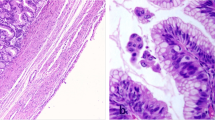Abstract
Background
Diagnostic terminology and grading of primary appendiceal mucinous neoplasms lacks uniformity. We sought to identify discordance in pathologic reporting by reviewing pathology slides for cases referred to our institution.
Methods
Using guidelines from Peritoneal Surface Oncology Group International (PSOGI) and American Joint Committee on Cancer 8th edition (AJCC8), we compared diagnostic terminology/grading of primary appendiceal mucinous neoplasms (n = 115) between pathology reports from referring institutions and review of slides by pathologists at our high-volume institution.
Results
There was discordance in pathologic terminology and grading of primary appendiceal mucinous neoplasms between referring institutions and our institution in 28% and 50% of patients, respectively. In particular, 24% of patients referred with mucinous adenocarcinoma (MACA) had LAMN on our review, and a higher grade MACA was found in 48% of patients referred with low-grade (G1) MACA and 16% of patients referred with high-grade (G2) MACA following our review. Discordance in tumor grade between primary and metastatic disease was seen in 19% of cases based on referred primary tumor grading compared with only 4% following our review. Systemic chemotherapy was unnecessarily administered to four cases of LAMN (6%) and inappropriately not administered to four cases of MACA (6%) before referral due to inaccurate diagnosis/grading by referring institutions.
Conclusions
We found significant discordance in diagnostic terminology/grading of primary appendiceal mucinous neoplasms following review of referred cases. Inaccurate pathologic assessment was associated with overtreatment or undertreatment with chemotherapy. These data highlight the need for pathologic review of such rare cases at high-volume centers.


Similar content being viewed by others
References
Connor SJ, Hanna GB, Frizelle FA. Appendiceal tumors: retrospective clinicopathologic analysis of appendiceal tumors from 7970 appendectomies. Dis Colon Rectum. 1998;41(1):75–80.
McCusker ME, Cote TR, Clegg LX, Sobin LH. Primary malignant neoplasms of the appendix: a population-based study from the surveillance, epidemiology and end-results program, 1973–1998. Cancer. 2002;94(12):3307–12.
Turaga KK, Pappas SG, Gamblin T. Importance of histologic subtype in the staging of appendiceal tumors. Ann Surg Oncol. 2012;19(5):1379–85.
Amini A, Masoumi-Moghaddam S, Ehteda A, Morris DL. Secreted mucins in pseudomyxoma peritonei: pathophysiological significance and potential therapeutic prospects. Orphanet J Rare Dis. 2014;9:71.
Choudry HA, O’Malley ME, Guo ZS, Zeh HJ, Bartlett DL. Mucin as a therapeutic target in pseudomyxoma peritonei. J Surg Oncol. 2012;106(7):911–7.
O’Connell JT, Tomlinson JS, Roberts AA, McGonigle KF, Barsky SH. Pseudomyxoma peritonei is a disease of MUC2-expressing goblet cells. Am J Pathol. 2002;161(2):551–64.
Sugarbaker PH. New standard of care for appendiceal epithelial neoplasms and pseudomyxoma peritonei syndrome? Lancet Oncol. 2006;7(1):69–76.
Bradley RF, Stewart JHT, Russell GB, Levine EA, Geisinger KR. Pseudomyxoma peritonei of appendiceal origin: a clinicopathologic analysis of 101 patients uniformly treated at a single institution, with literature review. Am J Surg Pathol. 2006;30(5):551–9.
Carr NJ, Sobin LH. Epithelial noncarcinoid tumors and tumor-like lesions of the appendix. Cancer. 1995;76(11):2383–4.
Davison JM, Choudry HA, Pingpank JF, et al. Clinicopathologic and molecular analysis of disseminated appendiceal mucinous neoplasms: identification of factors predicting survival and proposed criteria for a three-tiered assessment of tumor grade. Mod Pathol. 2014;27(11):1521–39.
Misdraji J, Yantiss RK, Graeme-Cook FM, Balis UJ, Young RH. Appendiceal mucinous neoplasms: a clinicopathologic analysis of 107 cases. Am J Surg Pathol. 2003;27(8):1089–103.
Pai RK, Beck AH, Norton JA, Longacre TA. Appendiceal mucinous neoplasms: clinicopathologic study of 116 cases with analysis of factors predicting recurrence. Am J Surg Pathol. 2009;33(10):1425–39.
Pai RK, Longacre TA. Appendiceal mucinous tumors and pseudomyxoma peritonei: histologic features, diagnostic problems, and proposed classification. Adv Anat Pathol. 2005;12(6):291–311.
Reu S, Neumann J, Kirchner T. Mucinous neoplasms of the vermiform appendix, Pseudomyxoma peritonei, and the new WHO classification. Pathologe. 2012;33(1):24–30.
Ronnett BM, Yan H, Kurman RJ, Shmookler BM, Wu L, Sugarbaker PH. Patients with pseudomyxoma peritonei associated with disseminated peritoneal adenomucinosis have a significantly more favorable prognosis than patients with peritoneal mucinous carcinomatosis. Cancer. 2001;92(1):85–91.
Ronnett BM, Zahn CM, Kurman RJ, Kass ME, Sugarbaker PH, Shmookler BM. Disseminated peritoneal adenomucinosis and peritoneal mucinous carcinomatosis A clinicopathologic analysis of 109 cases with emphasis on distinguishing pathologic features, site of origin, prognosis, and relationship to “Pseudomyxoma peritonei.” Am J Surg Pathol. 1995;19(12):1390–1408.
Shetty S, Natarajan B, Thomas P, Govindarajan V, Sharma P, Loggie B. Proposed classification of pseudomyxoma peritonei: influence of signet ring cells on survival. Am Surg. 2013;79(11):1171–6.
Carr NJ, Bibeau F, Bradley RF, et al. The histopathological classification, diagnosis and differential diagnosis of mucinous appendiceal neoplasms, appendiceal adenocarcinomas and pseudomyxoma peritonei. Histopathology. 2017;71(6):847–58.
Carr NJ, Cecil TD, Mohamed F, et al. A Consensus for Classification and Pathologic Reporting of Pseudomyxoma Peritonei and Associated Appendiceal Neoplasia: The Results of the Peritoneal Surface Oncology Group International (PSOGI) Modified Delphi Process. Am J Surg Pathol. 2016;40(1):14–26.
Acknowledgment
This work was partially funded by generous support from Valarie Koch and the New Era Cap Company. The project was supported by the National Institutes of Health through Grant Number UL1-TR-001857, using a Redcap maintained database.
Author information
Authors and Affiliations
Corresponding author
Ethics declarations
Disclosures
None
Additional information
Publisher's Note
Springer Nature remains neutral with regard to jurisdictional claims in published maps and institutional affiliations.
Rights and permissions
About this article
Cite this article
Choudry, H.A., Pai, R.K., Parimi, A. et al. Discordant Diagnostic Terminology and Pathologic Grading of Primary Appendiceal Mucinous Neoplasms Reviewed at a High-Volume Center. Ann Surg Oncol 26, 2607–2614 (2019). https://doi.org/10.1245/s10434-019-07447-z
Received:
Published:
Issue Date:
DOI: https://doi.org/10.1245/s10434-019-07447-z




